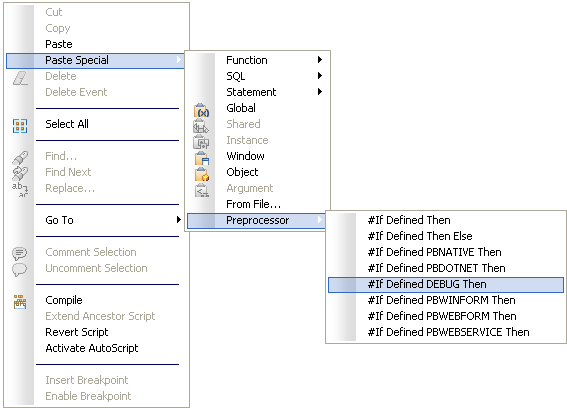You can use the syntax #IF DEFINED followed by a predefined preprocessor symbol to mark a block of code for specialized processing before it is compiled. The block of conditional code is automatically parsed by a PowerBuilder preprocessor before it is passed to the compiler. Most of the predefined preprocessor symbols are used only for .NET targets, but the DEBUG symbol can be used in standard PowerBuilder targets as well.
The symbol is useful if you want to add code to your application to help you debug while you are testing the application. For example, you might add a block like the following:
#if defined DEBUG then
MessageBox("Debugging","Ctr value is " + string(i))
#end if
When you run or debug the application in the development environment, the code is always parsed and you always see the message box. When you run the executable file, the code is parsed only if the DEBUG symbol is enabled on the General page in the Project painter. While you are still testing the application, turning the DEBUG symbol can help you find differences in behavior in the development environment and the executable file.
Although you would not typically enable the DEBUG symbol in a release build, if a problem is reported in a production application, you can redeploy the release build with the DEBUG symbol enabled to help determine the nature or location of the problem.
When you use the DEBUG symbol, you can add breakpoints in the DEBUG block only for lines of code that are not in an ELSE clause that removes the DEBUG condition. If you attempt to add a breakpoint in the ELSE clause, the debugger automatically switches the breakpoint to the last line of the clause defining the DEBUG condition. Consider this code:
#if defined DEBUG then /*debugging code*/ #else /* other action*/ #end if
In this example, if you add a breakpoint to the line /* other
action*/, the breakpoint would
automatically switch to the line /*debugging
code*/.
![]() Code in ELSE clause is parsed
Note that any code that you place in the ELSE clause will
be parsed by the compiler when you build an executable file with
the DEBUG symbol disabled.
Code in ELSE clause is parsed
Note that any code that you place in the ELSE clause will
be parsed by the compiler when you build an executable file with
the DEBUG symbol disabled.
You can use the Paste Special>Preprocessor>#If Defined DEBUG Then pop-up menu item in the Script view to paste a template into a script.

Conditional compilation is not supported in DataWindow syntax, structure or menu objects. You cannot edit the source code for an object to include conditional compilation blocks that span function, event, or variable definition boundaries.
You must rebuild your application after you add a DEBUG conditional block.